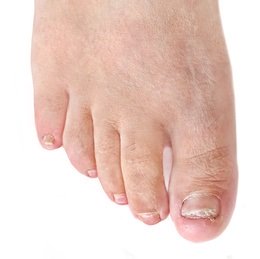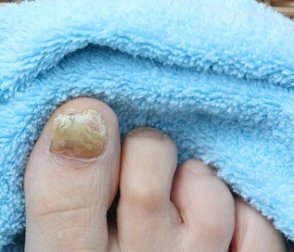
In this nail fungus topical treatment guide, we’ll tell you about the different topical treatments available for getting rid of nail fungus, technically referred to as onychomycosis. It often affects toenails but can affect fingernails, too. Onychomycosis causes nails to grow abnormally thick, to turn yellowish or dark in color, and to crumble. The condition can be rather painful, as well.
Topical treatments are often very effective for treating nail fungus and they may even be preferred to other options because they carry a lower risk of side effects than things like oral antifungal medications and they are much more affordable and much less painful than surgery, but there are times when other treatment options may be a better choice. We’ll let you know when to consider other options.
Medicated Nail Creams
Medicated creams or ointments like ketoconazole (brand name Nizoral Cream) and terbinafine (brand name Lamisil Cream) are often used to treat nail fungus. Medicated nail creams are a good treatment option for people that can’t take oral antifungal drugs for some reasons or for those that are concerned about the possible side effects of prescription drugs. Serious side effects are rare but it can take several months to get rid of nail fungus completely with medicated nail creams.
Sometimes medicated creams are prescribed along with oral antifungal drugs. This increases the risk of serious side effects, though, and there is some debate about whether or not topical medications and oral medications should be used at the same time, so discuss the risks and benefits with your doctor before deciding what treatment is best for you.
Lotions Containing Urea

Lotions containing urea, a substance that breaks down proteins, are sometimes used to help soften and thin the nails in order for medicated nail creams like Nizoral Cream or Lamisil Cream to be able to penetrate the nail more deeply and therefore work better. These lotions won’t cure nail fungus, though. They have to be used in conjunction with nail creams that contain antifungal medications. Lotions containing urea are available over the counter. Ask your pharmacist if you need assistance selecting one.
Medicated Nail Polish
Ciclopirox nail lacquer (brand name Penlac) is applied to the affected nails just like nail polish. You apply it once a day and after seven days, use rubbing alcohol to remove it. After trimming the nail and filing away any loose nail parts, you apply the nail lacquer again. Side effects are usually minor but it can take a very long time, up to a year, to get rid of nail fungus using ciclopirox.
When a Nail Fungus Topical Treatment Might Not Be Best For You
If your nail is severely infected or very painful, your doctor might recommend surgically removing the nail(1). There are also oral antifungal medications that work faster than topical treatments. Doctors don’t always like to prescribe them since they can cause serious side effects and shouldn’t be used by people with certain liver or heart problems. Some people have trouble following through with applying topical treatments daily for week after week, though, and might be better able to stick to an oral medication regimen. In addition, if more than half the nail is involved, topical treatments may not be sufficient. Talk to your doctor if you have questions about whether or not a nail fungus topical treatment is appropriate for you.
Our Favorite Nail Fungus Topical Treatment
Our favorite topical treatment for getting rid of nail fungus is Funginix. It’s available without a prescription and comes with a 60-day money back guarantee if you’re not satisfied with it, so you have nothing to lose. Funginix contains a medication called undecylenic acid, which prevents the growth of fungus, along with ingredients like lavender essential oil and tea tree oil, which help fight fungal infections naturally. To learn more about our favorite topical treatment for nail fungus, just follow this link to the Funginix Website.
